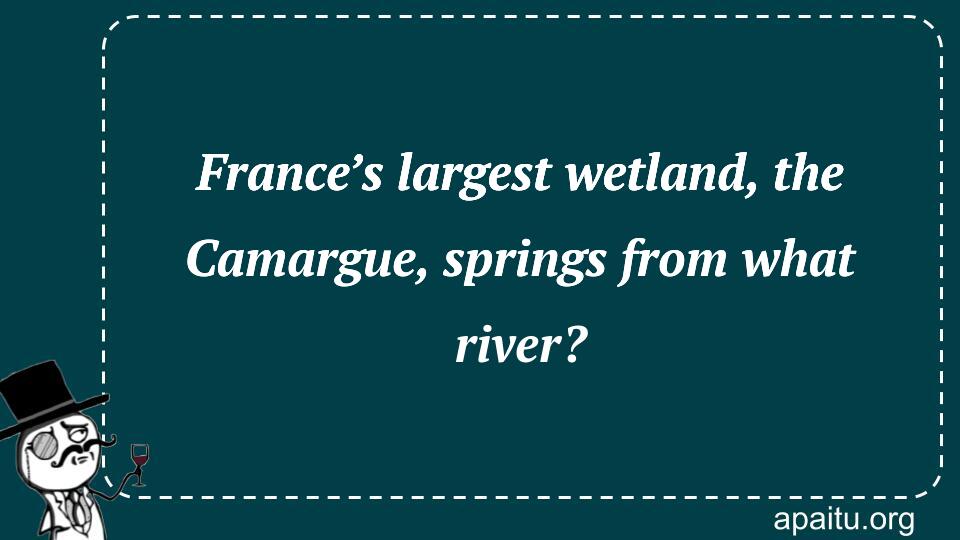Question
Here is the question : FRANCE’S LARGEST WETLAND, THE CAMARGUE, SPRINGS FROM WHAT RIVER?
Option
Here is the option for the question :
- Seine
- Loire
- Rhône
- Garonne
The Answer:
And, the answer for the the question is :
Explanation:
The Camargue, which is the largest wetland in France, is created by the Rhône River in the southeast of the nation. The Camargue horse, an ancient breed of horse native to the area and claimed to be one of the oldest horse breeds on Earth, is among the remarkable animals present in the marsh. The Camargue has about one-third of all flowering plants in France.

The Camargue, France’s largest wetland, is a captivating natural region that owes its existence to the mighty Rhône River. Nestled in the delta of the Rhône, this unique wetland is a haven for diverse flora and fauna, attracting nature lovers and wildlife enthusiasts from around the world. The symbiotic relationship between the Camargue and the Rhône River has shaped the wetland’s distinctive landscapes, rich biodiversity, and cultural heritage, making it a cherished gem of France.
The Rhône River, one of Europe’s major waterways, plays a pivotal role in the formation and sustenance of the Camargue wetland. Originating in the Swiss Alps, the river meanders through Switzerland and France before reaching the Mediterranean Sea. As it approaches the coast, the Rhône splits into multiple distributaries, forming a vast delta characterized by intricate networks of channels, lagoons, and marshes. It is within this deltaic landscape that the Camargue flourishes.
The Camargue’s unique geography owes its existence to the complex interplay between the Rhône River’s flow and the forces of nature. The river carries vast amounts of sediment from its upstream catchment, depositing it in the delta as it slows down and spreads out. Over time, these sediments accumulate and form the fertile soils that support the wetland’s diverse vegetation. The continuous interaction between the Rhône and the wetland shapes the Camargue’s dynamic landscapes, characterized by salt marshes, brackish lagoons, reed beds, and vast expanses of wet meadows.
The Camargue’s wetland ecosystem is a sanctuary for an impressive array of plant and animal species, some of which are unique to the region. The wetlands serve as critical nesting and breeding grounds for numerous waterbirds, including flamingos, herons, egrets, and ducks. The marshes and lagoons provide abundant food sources, attracting migratory birds that travel thousands of kilometers to reach this haven. The wetland is also home to iconic Camargue horses, semi-feral cattle, and an array of amphibians, reptiles, and small mammals.
Beyond its ecological significance, the Camargue holds cultural and historical importance for the people of France. The wetland has a rich heritage dating back centuries and is deeply intertwined with the traditions and lifestyle of the Camargue’s inhabitants. The local communities, including the Camarguais people, have developed a unique relationship with the wetland, relying on its resources for agriculture, fishing, and traditional activities such as bullfighting and horseback riding.
Recognizing the ecological value and cultural heritage of the Camargue, concerted efforts have been made to preserve and protect this remarkable wetland. The wetland is designated as a regional nature park and is subject to strict conservation measures. Sustainable land management practices, including controlled grazing, controlled water levels, and reed cutting, are employed to maintain the de